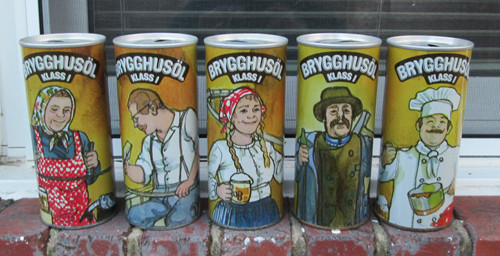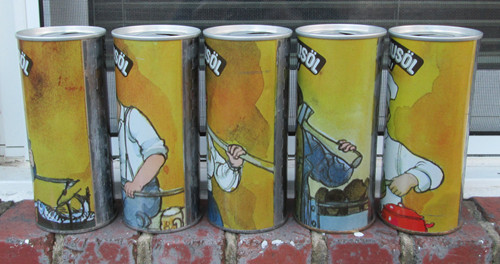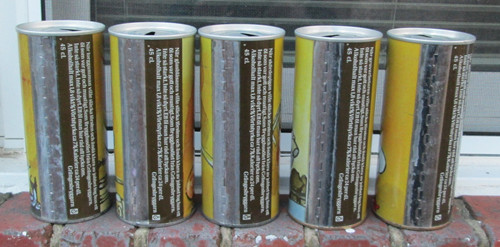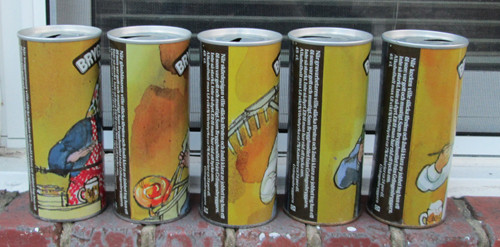Swedish Craft Set (circa 1976)
This is a set of four cans from Sweden's Brygghusol Brewery. It doesn't really fit my normal collection. However, I like it because I have fond memories of the 1970s Swedish can sets from when I started collecting in 1976.
 |
There are five different crafts or trades represented here. They include, from left to right...
Nar torggumman “old lady selling fish”
Nar glasblasaren “glass maker”
Nar skordepigan “farming girl”
Nar gruvarbetaren “miner”
Nar kocken “cook”
The International Temperance Movement
The "KLASS 1" in the label indicates that the contents were low alcohol and could be sold in supermarkets. The Klass designation is required by Sweden's system to regulate alcohol which developed as part of the international temperance campaigns that in the US led to the 18th amendment. Most Americans are not aware that the US movement to ban alcoholic beverages was part of a larger international campaign. There were temperance movements all over the world, and they had other successes besides the 18th Amendment in the US. For example, Canada voted for nationwide prohibition in 1898, but Ottawa did not enact it leaving it to the individual provinces and local governments. It had passed with only a bit over 51% of the vote in a low turnout election, and Quebec had been overwhelmingly against it. As with the US, the First World War (1914-1918) provided the final push that the drys needed. Only Prince Edward Island had enacted full providence-wide prohibition before 1914, but by 1918 the majority had gone dry. The Northwest Territories were dry from 1874 to 1891, but not thereafter. Quebec and Nova Scotia went dry in 1919 and 1921, respectively, but Quebec's lasted only a year. Starting with Quebec in 1919 and Yukon in 1920, one by one the Canadian provinces abandoned prohibition. By 1930 all the Canadian provinces except Prince Edward Island were again "wet."
Other nations tried prohibition or some sort of control as well. Russia went somewhat dry under the Czar in 1914, allowing the sale of hard liquors only in restaurants. The USSR kept the Czarist law until 1925. Iceland tried it from 1915-1933. Norway from 1916-1927, and Finland from 1915-1932. The short-lived Hungarian tried it for a few months in 1919 before it collapsed. In Britain pub hours were severely restricted, beer was very heavily taxed (doubling the price of a pint), and the average alcohol content dropped.
Some of the countries that tried prohibition did so as a war measure to save grain, to prevent drunken soldiers and sailors, and to keep a sober workforce for war industries. The Scandinavian countries were neutral, but had a strong Protestant religious movement that supported the dry efforts. Many other nations had a temperance movement at this time, but were not as successful as they were in the US, Canada, and Scandinavia.
The Klass System
Sweden used a rationing system, called the Bratt System, from 1917-1955. When this months cans were made Sweden was using a new system for beer. Only classes I and II can be purchased in supermarkets, while class III can only be purchased in restaurants licensed to do so, and the state shops called Systembolaget. Class II beer is loosely divided into two sub-groups, light "Folköl" ("People's Beer") with a maximum ABV of 2.8% and normal "Folköl", with a maximum ABV of 3.5%.
Class III beer is also, unofficially, divided into two sub-groups, "Mellanöl" ("in-between beer"), with ABV between 3.6% and 4.5%, and normal "strong beer" with ABV above 4.5%. There is no real maximum amount of how much alcohol Class III beer may contain, and amounts of 10%+ are common. Mellanöl used to be available in supermarkets between October 1, 1965 and July 1, 1977, but was removed from the supermarkets due to heavy consumption by teenagers. Before 1997, alcohol by weight was used, and then the limit for shops was 2.8 %, same as 3.5 % alcohol by volume, which was a source of confusion.
The Cans
Here are the sides and the backs of the cans.
 |
 |
 |
It's not a rare set by any means. You can usually find it for somewhere between $15-$25.00 US on eBay or at shows.
Sources
(Links open new pages)
Wikipedia: "Systembolaget"
Wikipedia: "Beer classification in Sweden and Finland"
